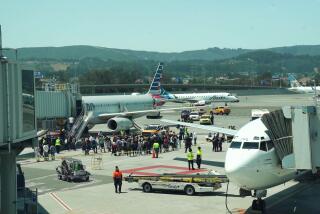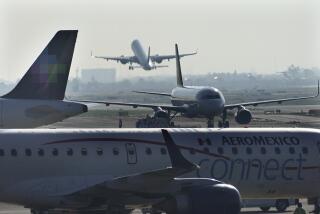Jet passengers overpower would-be bomber
Reporting from New York — In what was described as an act of terrorism, a Nigerian passenger attempted to ignite an incendiary device aboard a Northwest Airlines flight from Amsterdam to Detroit on Friday as the plane began its approach for landing, federal officials said. Other passengers overpowered the man and the plane landed safely.
The suspect, identified as Abdul Mutallab, 23, suffered severe burns as a result of the attempt, authorities said, and two of the other 277 passengers reported minor injuries.
FBI agents were investigating the incident, which a White House official said was an attempted act of terrorism.
“He was trying to ignite some kind of incendiary device,” said a federal anti-terrorism official, who requested anonymity because of the sensitivity of the case. “He lit himself on fire and he’s suffered some burns.”
The device, which mixed powder and liquid, was said to be less powerful than a bomb.
President Obama was briefed on the incident during his Hawaii vacation, the White House said in a statement, and airport security was stiffened worldwide.
The suspect -- an engineering student at University College of London, according to ABC News and NBC News -- began his trip Thursday from Nigeria. It was not clear Friday whether Mutallab underwent security screening in Amsterdam or merely changed planes there.
It also was uncertain Friday night whether the suspect had ties to a terrorist organization or had attempted the attack on his own, authorities said. Despite earlier reports that he had claimed a connection to Al Qaeda, Mutallab denied any such link in later statements to FBI agents interrogating him, the anti-terrorism official said.
“Right now he is saying he was not part of an organization or a coordinated effort. I want to caution people from jumping headlong into the Al Qaeda link because it’s a very murky area,” the official said.
The suspect smuggled a powder aboard the plane in a container taped to his leg, the official said.
Covering himself with a blanket to hide his actions, he used a syringe to inject a liquid into the powder, and a fire resulted from the combustible mix, according to the official, who did not identify the materials.
The official denied reports that Mutallab had been on the federal “no-fly” list of suspected extremists and other potentially dangerous individuals, which is shared with airlines. But the official did not rule out the possibility that the Nigerian had been on some other U.S. government database.
Various media reports spelled the suspect’s name different ways. The Associated Press gave his full name as Umar Farouk Abdul Mutallab.
The Northwest jet, an Airbus 330 with Delta markings, landed about noon local time. (The two airlines merged in April 2008.) It carried a crew of 11.
Those aboard described some panic after noises like firecrackers, then quick, heroic actions.
Syed Jafri, a U.S. citizen who had flown from the United Arab Emirates, said the incident occurred during the plane’s descent, according to the Associated Press. Jafri said he was seated three rows behind the passenger and said he saw a glow and smelled smoke. Then, he said, “a young man behind me jumped on him.”
“Next thing you know, there was a lot of panic,” Jafri said.
Peter Smith, another passenger, told WJBK Fox 2 in Detroit that one man saw the flames and leaped across the aisle to help extinguish them. “He jumped over all the other people and he took care of it, so the fire went out,” Smith said.
The heroic passengers were not publicly identified Friday.
Iliaa Schelke, another passenger, told the station: “We heard a loud pop and a bit of a smoke and then some flames and yelling and screaming. And then somebody said the guy was subdued and they took him out. It was really quick.”
The suspect was described as having his hands wrapped in bandages and being handcuffed to a stretcher as he was taken off the plane.
Dawn Griffith, 42, of Pontiac, Mich., said she was waiting for her husband, Rich -- a contractor working as an electrician in Iraq for the last three years -- to arrive from Amsterdam. Then she saw a young man being wheeled out on a gurney.
“That’s when I knew something was wrong,” Griffith said. “It was really weird. He didn’t look like he was agonized. He looked subdued and they had him covered up.”
She said the airport teemed with ATF and FBI agents and police dogs. Griffith said it was about five hours before her husband and the rest of the passengers got off the plane. He was too far back to see what had happened, she said, but he could tell there was a commotion in the middle of the plane.
“He’s been in Iraq and seen some terrible things, and he doesn’t want any of that to happen here,” she said.
In the White House statement, issued from Kailua, Hawaii, the administration said that Obama had conferred with White House counter-terrorism advisor John Brennan and National Security Council Acting Chief of Staff Denis McDonough and had instructed that “all appropriate measures be taken to increase security for air travel.”
The Department of Homeland Security said passengers might see additional screening measures on domestic and international flights because of the incident and urged travelers to report any suspicious activity or behavior to law enforcement officials.
“We encourage those with future travel plans to stay in touch with their airline and to visit www.TSA.gov for updates,” the department said.
Nigerians have not figured in many cases involving Al Qaeda, but the rise of violent Islamic extremism in that country -- as well as in sub- Saharan Africa overall -- concerns Western anti-terrorism officials.
The timing and description of the incident recall the attempted attack on a Paris-to-Miami flight eight years ago by “shoe bomber” Richard Reid, a British Al Qaeda operative who was convicted in U.S. federal court of trying to blow up the American Airlines flight.
Soon after takeoff from Paris on Dec. 22, 2001, Reid tried to ignite explosives that had been packed into his high-top gym shoes in an attempt to blow a hole in the plane. A flight attendant and a passenger subdued Reid and foiled the attack, which spread fear across the world just three months after the Sept. 11 attacks.
Reid was one of several bombers whom Al Qaeda trained in its Afghan camps to commit attacks aboard planes carrying concealed explosives.
In August 2006, British police working with U.S. and Pakistani intelligence broke up a plot in which Al Qaeda trained Britons in Pakistan to assemble liquid-based bombs that would have been smuggled aboard planes in energy drinks and other containers.
The investigation revealed that the ingenious technology in that plot was developed in Pakistan by Abu Ubaida al Masri, Al Qaeda’s operations chief at the time.
It would have involved teams of two or three attackers smuggling aboard the explosives and separate ignition devices to blow up seven planes bound for North America.
Since then, passengers have been prohibited from carrying liquids aboard in containers larger than 3 ounces.
Staff writers Alana Semuels in Kailua, James Oliphant in Washington and Ari Bloomekatz, Hector Becerra and Larry Gordon in Los Angeles contributed to this report.
More to Read
Sign up for Essential California
The most important California stories and recommendations in your inbox every morning.
You may occasionally receive promotional content from the Los Angeles Times.










